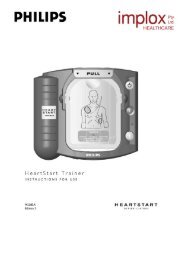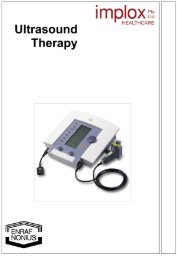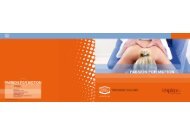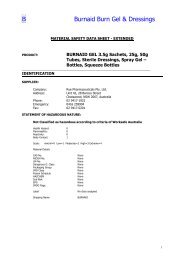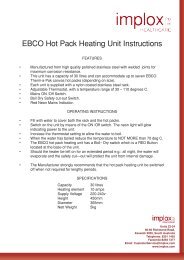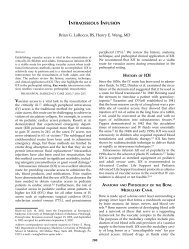CASMED 740 Vital Signs Monitor - Implox
CASMED 740 Vital Signs Monitor - Implox
CASMED 740 Vital Signs Monitor - Implox
Create successful ePaper yourself
Turn your PDF publications into a flip-book with our unique Google optimized e-Paper software.
<strong>CASMED</strong> <strong>740</strong> <strong>Monitor</strong>s<br />
Refer to Table 8: Error Messages on the Message Window for more information.<br />
If the monitor is in need of repair, it must be referred to the appropriate service personnel.<br />
Service performed by unauthorized personnel could be detrimental to the monitor and will void<br />
the warranty. For service, contact your dealer or CAS Medical Systems, Inc.<br />
SpO 2 USER MESSAGES<br />
(available if SpO 2 is installed)<br />
If the accuracy of any measurement does not seem reasonable, first check the patient’s vital<br />
signs by an alternate method.<br />
NOTE:<br />
The SpO 2 probe must be kept as motionless as possible to make a proper determination. Use<br />
the SpO 2 strength bar graph to determine if a strong rhythmic pulse signal is present.<br />
When no oximeter probe is attached to the monitor, the %SpO 2 window and signal strength<br />
window will be blank. When no SpO 2 pulse data is available, the monitor will display the last<br />
NIBP pulse.<br />
When the probe is connected to the monitor, but is off of the patient, the message “–“ is<br />
displayed in the %SpO 2 and Pulse Rate windows. The Message Window flashes the message<br />
“Prb OFF” and three (3) audio “beeps“ are heard every twenty-five (25) seconds.<br />
Press the SILENCE/RESET pushbutton. The monitor silences the audible alarm tone, but the<br />
message remains.<br />
If the message “Prb” should appear in the %SpO 2 window, verify that the probe being used is the<br />
correct one for the monitor’s SpO 2 configuration (Masimo, Nellcor, Nonin) or that the probe is not<br />
defective.<br />
Press the SILENCE/RESET pushbutton. The monitor silences the audio alarm tone, but the<br />
message remains. Remove the defective probe and replace it with a working probe.<br />
Each sensor is designed for a specific clinical application.<br />
NOTE:<br />
Inaccurate measurements may be caused by:<br />
• anemia or low hemoglobin concentrations<br />
• electrosurgical interference<br />
• excessive ambient light<br />
• excessive patient movement<br />
• incorrect sensor application or use<br />
• intravascular dyes such as indocyanine green or methylene blue<br />
• moisture in the sensor<br />
• placement of a sensor on an extremity with a blood pressure cuff, arterial catheter, or<br />
intravascular line<br />
• venous pulsations<br />
21-02-0298 REV. 00 12/06<br />
109





